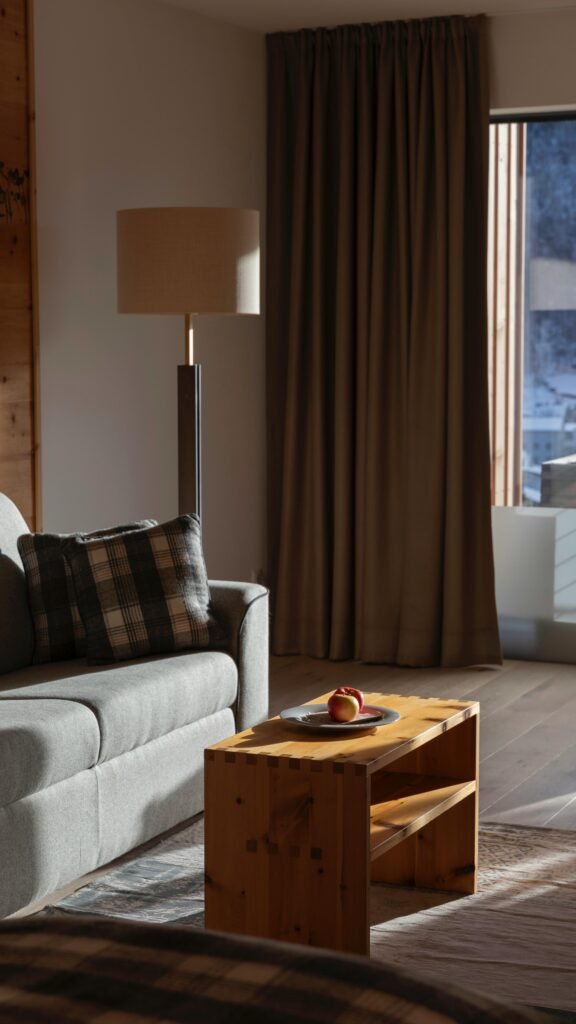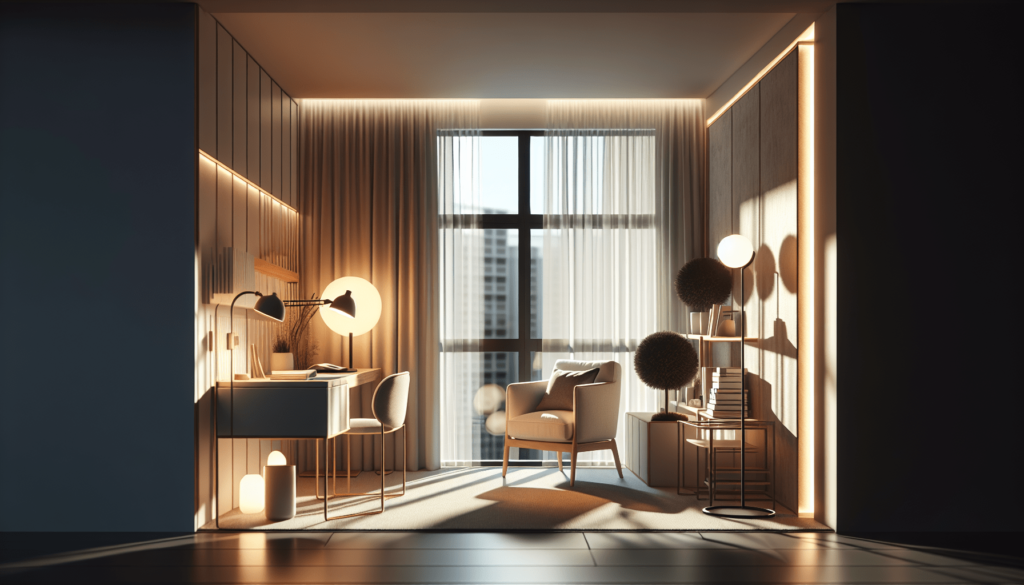In this article, you will discover practical and creative lighting solutions designed specifically for small living spaces. Whether you’re living in a cozy apartment or a compact house, finding the right lighting can make all the difference in creating a warm and inviting atmosphere. From utilizing natural light to maximizing the use of mirrors and strategic placement of lamps, these tips will help you transform your small space into a well-lit haven that feels both spacious and stylish. Get ready to shine a light on your mini oasis!
Natural Lighting
Natural lighting is a great way to brighten up any space, especially in small living spaces where every bit of light matters. To take advantage of natural light, make sure you have plenty of windows and skylights in your home. These openings allow sunlight to flood into the room, creating a warm and inviting atmosphere. When choosing window treatments, it’s important to keep them minimal to allow maximum light to enter the space. Light-colored curtains or blinds are a great choice as they reflect light rather than absorbing it. For those concerned about privacy, sheer curtains are an excellent option as they let light in while still maintaining your privacy.
Overhead Lighting
In addition to natural lighting, overhead lighting is essential in small living spaces. It provides general illumination and helps create a well-lit environment. One way to incorporate overhead lighting is by installing recessed lighting. Recessed lights are sleek and understated, making them perfect for small spaces as they don’t take up much visual space. Another option is to use slim flush mount fixtures. These fixtures are installed directly onto the ceiling, providing ample lighting without being bulky or obtrusive. Track lighting is also a great choice as it allows you to direct light exactly where you need it. Lastly, consider hanging pendant lights with adjustable height. This allows you to customize the lighting to suit your needs, whether it’s to illuminate a dining area or create a cozy reading nook.

Task Lighting
Task lighting is crucial for performing specific activities such as reading, cooking, or working at a desk. To provide adequate task lighting, there are several options you can consider. Desk lamps are a versatile choice as they can be easily moved around and directed towards your workspace. In the kitchen, installing under-cabinet lighting is a smart idea as it illuminates the countertops, making food preparation easier and safer. For bedtime reading, attach wall-mounted reading lights near the bed. This not only adds functionality but also saves space on your bedside table. If you have a cozy reading nook, place a floor lamp next to it to create an inviting and well-lit spot for relaxation.
Wall Sconces
Wall sconces are an excellent choice for small living spaces because they save valuable floor and table space. By mounting wall sconces, you can add both style and functionality to your room. Choose adjustable or swing arm sconces to direct light exactly where you need it. This allows you to customize the lighting according to your preferences and specific tasks. Consider installing dimmable wall sconces for added versatility. This feature allows you to adjust the brightness of the light to create the desired ambiance. Some wall sconces even come with built-in USB ports, which can be incredibly convenient for charging your devices without taking up precious outlet space.

Mirrors and Reflective Surfaces
Using mirrors and reflective surfaces strategically can greatly enhance the lighting in a small living space. Hang mirrors on walls opposite windows to reflect natural light and create an illusion of space. Mirrored furniture or accessories can have a similar effect, bouncing light around the room and making it appear larger and brighter. Additionally, placing reflective surfaces strategically, such as metallic finishes on furniture or shiny countertops in the kitchen, can help reflect and amplify both natural and artificial light.
Smart Lighting Solutions
Smart lighting solutions offer convenience and flexibility in controlling your lighting. By installing smart bulbs that can be controlled with a smartphone, you can easily adjust the lighting in your home. This allows you to create different moods and atmospheres at the touch of a button. Smart plugs are another useful tool that can automate your lighting schedules. You can set timers or even control them remotely, ensuring that your lights are turned on or off even when you’re away. For energy efficiency, consider setting up motion sensor lights. This ensures that lights are only turned on when someone is in the room, saving both energy and money. And if you have a voice-activated smart assistant, you can easily connect your lights and control them with voice commands for a seamless and hands-free lighting experience.

Flexible and Portable Lighting
Flexibility is key in small living spaces, and having lighting options that can be easily adjusted or moved around can make a big difference. Choose table lamps with adjustable arms or goosenecks so you can direct the light wherever you need it. This is especially useful for tasks such as reading or working on a project. Opting for clip-on lights gives you even more versatility as you can attach them to various surfaces, such as a desk or headboard. If you have areas without easily accessible outlets, battery-powered LED lights are a practical solution. They can add light to any corner of your space without the need for wiring. Lastly, investing in portable lanterns provides a great option for outdoor lighting needs, whether it’s for a cozy evening on your balcony or a gathering in your backyard.
Lighting Placement
When it comes to lighting placement in small living spaces, it’s important to focus on illuminating key areas. These include workstations, seating areas, and areas where you perform specific activities. By ensuring that these areas are well-lit, you create a functional and comfortable environment. Additionally, highlighting architectural features with accent lighting can add visual interest and depth to your space. Avoid harsh shadows by placing lights strategically, such as using multiple light sources to evenly distribute light and soften any harsh contrasts. Lastly, consider lighting artwork or shelves to add depth and highlight your personal style.

Lighting Control
Having control over your lighting is essential for creating the desired ambiance and functionality. Dimmer switches are a great addition as they allow you to adjust the brightness of the lights according to your needs and preferences. If you want to take it a step further, consider installing a lighting control system. This allows you to control all the lights in your home from one central location, providing maximum convenience. Utilize remote controls or smartphone apps for even more accessibility and ease of use. And if you want to save energy, invest in timers or sensors that automatically turn off lights when they are not needed, ensuring that energy is being used efficiently.
Light Bulb Selection
Choosing the right light bulbs is essential for both energy efficiency and achieving the desired lighting effect. LED bulbs are highly recommended for small living spaces as they are energy-efficient and have a long lifespan. They consume less energy while providing bright and quality light. Consider bulbs with adjustable color temperature to create different atmospheres and moods in your space. This can be particularly useful in areas such as the living room or bedroom where you may want to have both bright, cool light for activities and warmer, soft light for relaxation. Opt for light bulbs with high CRI (Color Rendering Index) to ensure that colors are accurately represented in your space. Lastly, compact fluorescent bulbs are a viable alternative to LED bulbs, offering energy efficiency and versatility in small living spaces.
By utilizing natural lighting, incorporating various types of lighting fixtures, and implementing smart lighting solutions, you can transform your small living space into a well-lit and inviting sanctuary. Remember to carefully consider the placement and control of your lighting, and choose the right light bulbs to optimize energy efficiency and create the desired ambiance. With these lighting tips, you can enhance the functionality and aesthetics of your small living space, making it a bright and comfortable place for you to enjoy.



